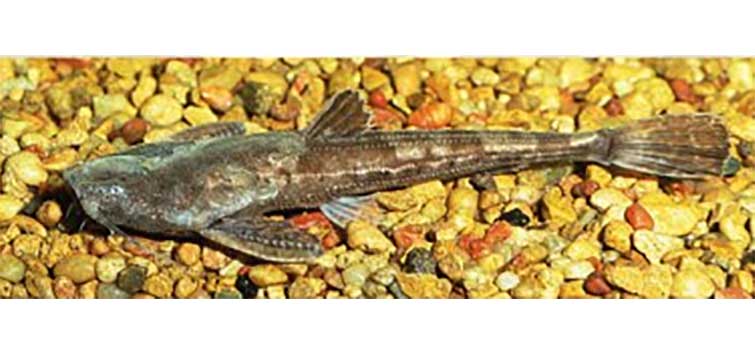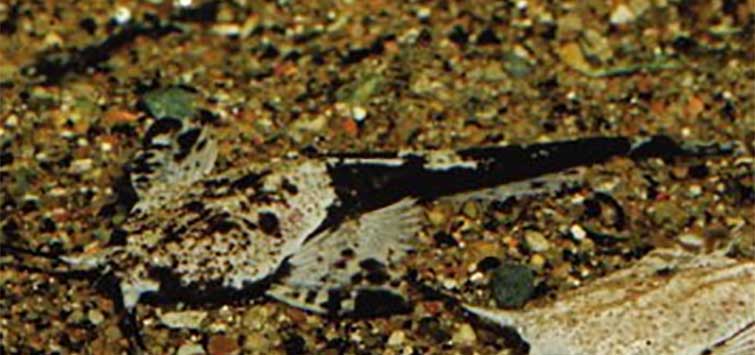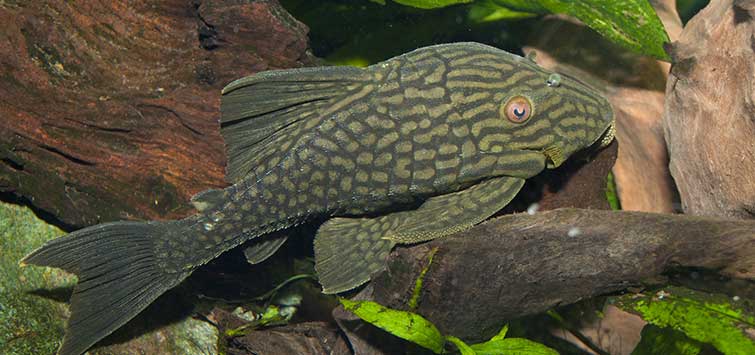The Banjo Cats
Author: Chris Ralph
Some of the more unusual-looking specimens to ever grace a freshwater aquarium, what the banjo catfishes lack in looks they make up for with their interesting characteristics and behavior.
Music to Our Ears
If the word “banjo” only conjures up an image of bluegrass music and square dances, then let me enlighten you about a fascinating family of catfish that are native to South America. The “banjos” belong to the family Aspredinidae, which includes genera such as Aspredo, Bunocephalus,and Platystacus. You might also come across old references in aquatic literature to genera that are no longer valid, such as Agmus and Disichthys.
The reason behind the “banjo catfishes” name is due to the fact that the fish have a flattened head and long midsection and tail, resembling the musical instrument. These catfish are also referred to as “frying pan catfishes.” I have to admit that they are perhaps not the prettiest group of catfishes available, but they are well worth looking out for.
Telling Tails
There are two groups of these fish that are generally recognized: short-tail banjos, which have an anal fin the same size as their head, and the long-tail banjos, which posses a very long anal fin and longer body. The anal fin of the short-tailed banjos has less than 10 rays, but in the long-fin cats it has 50 to 60.
Playing Dead
These catfish are quite often overlooked by the aquarist, most likely due to the fact that they usually hide in the tank or just generally look as if they are dead. The very fact that these catfish give the appearance of death is a natural defense against potential predators—after all, not many fish would be interested in eating something resembling a fallen leaf. Their typical coloration, which is predominantly brown, also helps them to blend in with their natural surroundings.
Species Characteristics
The banjos are characterized by the fact that their bodies tend to be depressed, are mostly naked (except for large tubercles), and sometimes have a row of small plates along the sides and dorsal and ventral surfaces. Their heads usually bear knob-like protuberances, while their gill openings tend to be small slits, and their pectoral fin spines tend to be strongly toothed. These catfish do not possess an adipose fin. The dorsal fin spine-locking mechanism is absent in most species of banjo catfish.
The largest representative of this family of catfish is Aspredo aspredo, which can attain a maximum length of 383 mm (15.1 inches), while most of the other representatives are below 15 cm (6 inches). Other characteristics associated with the family Aspredinidae include the fact that they posses six barbels, a short dorsal fin, terminal or sub-terminal mouths, and villiform teeth, which are arranged in bands on the jaws with no teeth being present on the vomer. The eyes of these catfish are very small and are situated on the top of their heads. When keeping banjos I have found that they like to bury themselves within the substrate, and sometimes it is only their minute eyes that you can see protruding from it.
Subfamilies
In 1983 it was documented by the Catfish Association of Great Britain that the subfamilies Bunocephalinae and Aspredininae were generally recognized, with the former containing seven genera and approximately thirty species and the latter containing six genera and seven or eight species. It was also noted that the validity of some genera and species was doubtful. There is not very much information available regarding the ecology and biology of this unusual group of catfish. It is documented that some of the aspreniids are salt tolerant and as such are naturally occurring in estuarine environments. As already mentioned, these catfish are generally found in fresh water, with some occasionally being found within brackish-water environments of tropical South America. It is also documented that some members of the subfamily Aspredininae live in coastal brackish waters.
Breeding
I am not aware of any member of this family of catfish having been bred in aquaria, which unfortunately means I could find no information regarding their breeding habits. It is suggested, however, that in fish of the genera Aspredo and Platystacus, eggs are attached to the abdomen of the female by an appendage. I am aware of one person in particular who is very passionate about this family of catfish, Trevor Morris of the Catfish Study Group (UK). While speaking to other catfish enthusiasts within the U.K., the banjos, while not the most popular group of fish, have been kept by most enthusiasts—and it would appear that some have kept more than one species.
Water and Substrate
These catfish tend to be very nocturnal, preferring to bury themselves within a sandy substrate such as aquarium sand. The “banjos” will tolerate water conditions with pH in the range of 6.0 to 8.0, temperature in the range of 20° to 28°C (68° to 82°F), and hardness in the range of 5° to 19° dGH, depending upon species.
Feeding
The ideal diet for these wonderful catfish should include bloodworms, Tubifex worms, whiteworms, earthworms, sinking catfish pellets, and catfish tablets, to name a few food types.
Varieties of Banjo Catfishes
The following are some of the various banjo catfishes you might come across, as well as some information about the size, background, and classification of each.
Bunocephalus verrucosus (Walbaum, 1792)
Common Name: Gnarled catfish
Subfamily: Bunocephalinae
Synonyms: Agmus lyriformis, Aspredo gronovii, Bunocephalichthys gronovii, Bunocephalus gronovii, Agmus scabriceps, Bunocephalus scabriceps, Aspredo verrucosa, Platystacus verrucosus, Silurus verrucosus, Bunocephalichthys verrucosus scabriceps, Bunocephalichthys verrucosus verrucosus
Size: 95mm (3.7 inches)
Origin: Guyana and Amazon River Basin
Color: The base color of the body is dark chocolate with some mottling, especially on the head plate. The barbels are banded. The dorsal, anal, ventral, and pectoral fins are black with a white margin, with the first rays being banded. The caudal fin is black with a white margin as with the remaining fins, while its outer rays are banded.
Body: This catfish has a very deep head which is said to be almost as deep as it is wide. The head is often described as being craggy, in reference to its head plate.
Bunocephalus amaurus Eigenmann, 1912
Common Name: Camouflaged catfish
Subfamily: Bunocephalinae
Synonyms: Bunocephalus amaurus aloikae, Bunocephalus amaurus sipaliwini
Size: 120mm (4.7 inches)
Origin: British Guiana
Color: The base color of the head and body is dark chocolate brown with a lighter saddle between the nuchal crest and the dorsal fin spine, with some lighter patches on the back between the dorsal and caudal fins. The barbels are banded. The caudal, anal and dorsal fins are dark brown to black in color with a white margin; the first rays of the dorsal and anal and the outer rays of the caudal are banded. The ventral fins are described as being mottled with a white margin. The pectoral fins are dark brown to black in color with the last rays being lightly mottled.
Body: The head plate has a shallow Y-shaped nuchal crest with its base just in front of the dorsal plate extending forward and dividing level to the base of the pectoral fin spine. The head and body are covered in minute tubercles. This catfish has nine rows of conspicuous tubercles around the caudal.
Platystacus cotylephorus Bloch, 1794
Common Name: Banded banjo
Subfamily: Aspredininae
Synonyms: Cotylephorus blochii, Silurus hexadactylus, Platystacus nematophorus, Aspredo sexcirrhis, Aspredo spectrum
Size: 320mm (12.6 inches)
Origin: South America; river estuaries in Brazil, Suriname, Venezuela, and the Guyanas. This catfish is documented as occurring in the lower portions of coastal rivers.
Color: The base color of the head and body is dark brown usually with creamy gray mottled markings on the dorsal surface of the skull and saddle-like patches along the back. The underside or ventral area is a lighter brown to cream color. The fins tend to be dark in color and sometimes have a lighter margin.
Body: The head is similar to that of Bunocephalus—broad, greatly depressed, and moderately smooth with a median ridge extending forward from the base of the dorsal fin spine dividing halfway and continuing nearly to the base of the maxillary barbels. This catfish has two pairs of rudimentary mandibular barbels with a pair of maxillary barbells, which are short with a membranous base. There are four rows of wart-like tubercles along the sides of the body. The body is much more slender and longer than that of Bunocephalus. The anal fin is long with 53 to 57 soft rays.
Aspredo aspredo (Linnaeus, 1758)
Common Name: Banjo, banjo catfish, eel-tailed banjo catfish
Subfamily: Aspredininae
Synonyms: Silurus aspredo, Aspredo batrachus, Platystacus laevis, Aspredo octocirrus, Aspredo sicuephorus, Aspredo sicyephorus
Size: 383mm (15.1 inches)
Origin: Brazil, French Guiana, Guyana, Suriname, Trinidad and Tobago, and Venezuela in both freshwater and brackish environments. This catfish is documented as being from the lower portions of coastal rivers.
Color: The base color of the head and dorsolateral body tends to be a uniform medium to light brown, which extends into the fins. The ventrolateral body coloration is much lighter, almost cream in color.
Body: The body is elongate, hence the common name eel-tailed banjo catfish.
Bunocephalus coracoideus (Cope, 1874)
Common name: Guitarrita (little guitar), banjo cat
Subfamily: Bunocephalinae
Synonyms: Bunocephalus bicolor, Dysichthys bicolor, Dysichthys coracoideus, Bunocephalus haggini
Size: 110mm (4.3 inches)
Origin: Bolivia, Brazil and Peru, Amazon River Basin.
Color: The base color of the head and body is dark brown to pale brown with dark bands and blotches. The entire body area is covered with small pale colored spots. The underside of the body is much paler in color and often has brown blotches. The fins are described as being a translucent brownish color with pale brown and black blotches. The caudal fin has a dark edge to it.
Body: The head and anterior part of the body are very strongly depressed and broad, tapering behind. The caudal peduncle is very long and compressed. The pectoral fin spines are very stout and serrated. The maxillary barbels are the longest of the three pairs and extend to the pectoral fin when laid back.
See the full article on TFH Digital http://www.tfhdigital.com/tfh/200711/#pg92

.png?h=595&iar=0&w=2781&hash=5FD5E69473BCC22199FBFA2FB71B6033)



